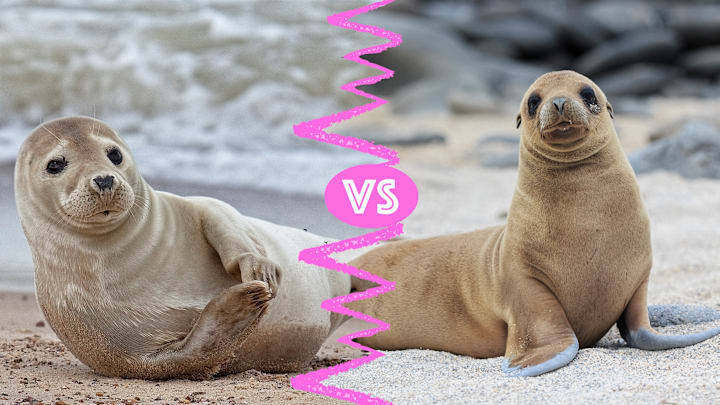At first glance, it might seem pretty easy to mistake a sea lion for a seal. As pinnipeds, which means “fin-footed” in Latin, these carnivorous marine mammals both have front flippers that help them glide through the water but also come ashore and hang out on the beach. To the naked eye, it could be hard to distinguish which is which.
Yet, while seals (specifically true seals) and sea lions might look similar, they come from different families in their taxonomy: Phocidae and Otariidae, respectively. Think of them as closely related cousins at a family reunion. Fur seals, which have thick fur, long flippers, and external ear flaps compared to true seals, are part of the Otariidae family, too. Meanwhile, walruses are in the same taxonomical suborder of pinnipeds as seals and sea lions, albeit they’re much larger, have big tusks, and belong to the family Odobenidae.
Pinniped | Family | Body size and coats | Ears | Front flippers | Noise Level |
|---|---|---|---|---|---|
True seals | Phocidae | Usually smaller, can have spots | Small ear holes, no external flaps | Short front flippers, “flop” by their bellies on land | Quieter, may “grunt” |
Sea lions and fur seals | Otariidae | Usually larger, don’t have spots | External ears with small flaps | Long front flippers, can “walk” on land | Very loud, known to “bark” |
Seals vs. Sea Lions: How Their Ears Differ
One of the biggest and most pronounced differences between seals and sea lions are their ears. The ears on a seal are internal with small openings on both sides of its head. They don’t have external ear flaps, whereas sea lions have external ears with small flaps, or pinnae. This is the best way to quickly identify the two animals at a glance.
Do Seals and Sea Lions Have the Same Kinds of Flippers?
Seals and sea lions have differently shaped front and hind flippers. With seals, the front flippers are shorter and thinly webbed; its hind flippers are used to move their lower bodies side-to-side underwater with speeds up to 23 miles per hour. Sea lions, on the other hand (or should we say flipper), have longer and stronger front flippers, which are used for propulsion. They can reach a top speed of between 25 to 30 miles per hour.
While both use their flippers for agility in swimming underwater, sea lions are better suited to using theirs for walking on land because they’re able to rotate their back flippers fully under their bodies. These back flippers are strong and flexible enough to support their weight, which can range from up to 800 pounds for males to up to 400 pounds for females. Conversely, the flippers on a seal are stubby, so whenever you see a seal on dry land, it wiggles and scoots forward on its belly, like a caterpillar.
Seals vs. Sea Lions: Are Their Coats the Same Color?
Speaking of bellies, the coat colors of seals and sea lions can vary. Seals range in shade from white, gray, and brownish black with dark or white spots, while sea lions are usually tan or chestnut brown with no visible spots. The presence of spots is another instant indicator that the marine mammal in question is a seal, like the small ear flaps on a sea lion.
Are Sea Lions Friendlier Than Seals?
Aside from their appearances, seals and sea lions don’t share the same demeanors or social behaviors. Although both animals look cute and cuddly, sea lions are more social and playful creatures than seals—and can sometimes even be caught dancing to tunes from Earth, Wind & Fire and the Backstreet Boys. Sea lions often gather along a coastline or beach in large herds (with sometimes up to 1500 fellow sea lions), while seals are more like loners, mostly opting to stay in the water or keep to themselves on land. In addition, sea lions are much noisier, using loud barks and howls to communicate and mark territory. Comparatively, seals are quiet and soft-spoken, emitting gentle grunts.
Do Seals and Sea Lions Live in The Same Areas?
Sea lions appear in nearly every ocean except the North Atlantic. Seals swim all over as well, but often do live in the North Atlantic. Moreover, seals are found in polar seas surrounding the Arctic and Antarctic, while sea lions often frequent temperate coastal areas. Seals and sea lions, however, do coexist in some areas, like along the Pacific Coast in the United States.
